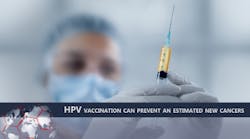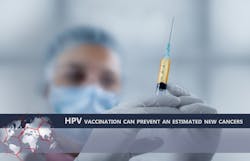The 101 on HPV: What health-care providers need to know about the HPV–oral cancer epidemic
Human papillomavirus–related oropharyngeal cancer is now considered an epidemic. As health-care professionals with initial screening methods, we must make the first move to guide our patients with reliable information. Choosing not to proactively educate our patients about the dangers of HPV–OPC could cost the lives of many to a preventable infection. Dr. Susan Maples shares the essentials on what you need to know about HPV and oral cancer.
Editor's note: This article first appeared in Breakthrough Clinical, the clinical specialties newsletter created just for dentists. Browse our newsletter archives to find out more and subscribe here.
We all know the pressure that dentists and dental hygienists have to endure for the well-being of their patients. Many of the exams we see as practical are largely unknown to the public. The exams are often discovered and promoted through health-care providers themselves and take a personal office campaign to get off the ground. Unfortunately, oral health is lower on the priority list for some patients, even those with good health management habits.
Human papillomavirus (HPV)–related oropharyngeal cancer (OPC) is now considered an epidemic, causing three-quarters of all oral cancers. HPV is usually linked with cervical cancer in women; however, HPV probably causes more OPC (1) according to the Centers for Disease Control and Prevention (CDC). It is a complicated diagnosis to give, but the rate of exposure is undeniably high for both male and female populations.
Tobacco, both smoking and smokeless, was the leading cause of oral cancer for the longest time. What most people are unaware of is that HPV took the lead. While lifestyle habits such as excessive alcohol consumption and genetics also play a role, HPV is thought to cause 70% of oropharyngeal cancers (2) in the United States. As practitioners, it is up to us to spread the word.
Exposure among different populations over time
Over the last seven years, the number of oral cancers has increased exponentially compared to an overall decline in all other cancers. So, what is the indicator here? Well, it simply comes down to the fact that when we look at cervical cancer, oral cancer, anal cancer, and other cancer types, HPV plays a major role. (3) Every day in the US, about 12,000 people ages 15 to 24 are infected with HPV. (4) According to data from the ongoing National Health and Nutrition Examination Survey (NHANES), approximately 26 million Americans on any given day have an oral HPV infection. (4)
This rate of transmission is eye-opening, but it isn’t impossible to prevent. The fault of most individuals in this situation is the lack of information on the topic. Patients are unaware that they can contract the oral HPV infection from unsafe oral sex with an infected partner. Early education is the best path to prevention.
The average age of first exposure to oral sex is in the teenage years. (5) As hard as it is for parents to face this reality, it is crucial for educated conversations to take place between young patients and their parents.
By 2020, HPV–related OPC rates in middle-aged men specifically are expected to surpass rates of cervical cancer in women. (6) Among those diagnosed with oral cancer, the fastest growing population of individuals are those under age 40 with HPV type-16. (7)
As health providers with the appropriate information and methods for initial screening, the ball falls in our court to make the first move. We must spread the word among children, teens, and young adults that oral sex is not safe sex and can easily lead to HPV transmission.
Benefits of early intervention and oral cancer screening
We are continually warned about the risks of women contracting cervical cancer from HPV exposure. Although this is true, it does not compare to the rates at which both men and women are contracting HPV and oral cancers as a consequence. An early oral cancer diagnosis can mean the difference between life and death. That conversation is a large responsibility for dental professionals to hold.
Without us informing our patients about the dangers of HPV–OPC, they may be left without the ability to swallow or chew. If OPC is not detected early, it is usually fatal. Early intervention allows time for specialists to evaluate the need for tumor removal or specific medicinal therapies. At every patient’s checkup, offer an oral cancer screening and explain the risks associated with the HPV infection and corresponding OPC.
Both boys and girls should receive the HPV vaccine around age 11. This acts as a preventive measure and lowers the risk of contracting oral cancers, as well as cervical cancers for females and penile cancers for males.
Breaking the news to your patients, gracefully
Our dental practices are the first places many individuals hear of the HPV–OPC outbreak. We must operate with sensitivity and compassion to alleviate the stress that can often accompany sensitive information. A formulaic approach using a professional tone of voice is the best manner with which to have the conversation with your patients. A private location allows for a relationship based on trust to be built between the practitioner and the patient, in addition to the preservation of anonymity. Be available to answer questions to the best of your ability during these conversations.
Leave your patients with guidance and encouragement
Our jobs as the trusted voice on the topic is not to induce fear. We must stay levelheaded even in the most tumultuous of times, and we must reassure our patients that they do have options. Information and guidance can go a long way toward helping patients stay on the healthiest preventive track.
Encourage your patients to take their health into their own hands with the Gardasil vaccine. There are more than 200 known strains of HPV (4)—and more emerging—but we are most concerned about HPV-16. The vaccine only protects against the nine most dangerous strains, but it is best to start somewhere. Be a health advocate for patients through your screening process and communication of reliable information.
Change your practice’s methods
The future of prevention starts in your office. Check each patient’s mouth for oral cancer at every dental visit. At this time, there are no effective screening methods for HPV–related oral cancer. The visible symptoms, if present, often hide behind tonsil folds or in the back of the mouth at the base of the tongue. If possible, conduct salivary diagnostic tests for your patients. For this type of exam, saliva is analyzed for the presence of HPV. (8) If the test is positive, you can help your patient build a personalized strategy for early oral cancer detection and eradicate the virus by building up his or her immune system.
How to motivate your patients
Emphasize the importance of clean living and healthy lifestyle choices with all of your patients. Motivate them to build a healthy immune system now to prevent diseases from causing havoc later. Encourage your patients to start with a good sleep schedule, a whole foods well-proportioned diet, adequate water intake, appropriate weight levels, and healthy habits. If the body can’t clear the HPV on its own, the patient carries a persistent HPV infection, (9) making him or her more susceptible to cancer.
A clean environment helps rid the body of toxins. One of the largest impacts on one’s health is stress. In fact, 75% to 90% of all doctors' office visits are for stress-related ailments and complaints. (10) In order to de-escalate the trend of oral cancers, we must start with preventive measures and sufficient informational campaigns. There is no time to disregard the research. If we choose not to be proactive, it is possible to lose a generation of middle-aged men and women to a preventable infection.
References
1. HPV and cancer: How many cancers are linked with HPV each year? Division of Cancer Prevention and Control, Centers for Disease Control and Prevention website. https://www.cdc.gov/cancer/hpv/statistics/cases.htm. Updated August 22, 2018. Accessed September 19, 2018.
2. HPV and cancer: HPV and oropharyngeal cancer. Division of Cancer Prevention and Control, Centers for Disease Control and Prevention website. https://www.cdc.gov/cancer/hpv/basic_info/hpv_oropharyngeal.htm. Updated August 22, 2018. Accessed September 19, 2018.
3. HPV and cancer: Which cancers are caused by HPV? U.S. Department of Health and Human Services. National Institutes of Health. National Cancer Institute website. https://www.cancer.gov/about-cancer/causes-prevention/risk/infectious-agents/hpv-fact-sheet#q2. Updated February 19, 2015. Accessed September 19, 2018.
4. HPV/oral cancer facts. The Oral Cancer Foundation website. https://oralcancerfoundation.org/understanding/hpv/hpv-oral-cancer-facts/. Accessed September 19, 2018.
5. DeNoon DJ. When do U.S. youths start oral sex, intercourse? WebMD website. https://www.webmd.com/sex-relationships/news/20120816/when-do-us-youths-start-oral-sex-intercourse#1. Published August 16, 2012. Accessed September 19, 2018.
6. Feibel C. The new face of HPV? Cases of throat cancer in men soon to surpass cervical cancers in U.S. Houston Public Media website. https://www.houstonpublicmedia.org/articles/news/2016/09/28/171461/men-with-throat-cancer-will-soon-outnumber-women-with-cervical-cancer-in-the-us/. Published September 28, 2016. Updated September 28, 2016. Accessed September 19, 2018.
7. Oral cancer facts: Rates of occurrence in the United States. The Oral Cancer Foundation website. https://oralcancerfoundation.org/facts/. Accessed September 19, 2018.
8. OraRisk HPV, complete genotyping testing from OralDNA Labs. OralDNA Labs website. https://www.oraldna.com/oral-hpv-testing.html. Accessed September 19, 2018.
9. Shanmugasundaram S, You Jianxin. Targeting persistent human papillomavirus infection. Viruses. 2017;9(8):229. doi: 10.3390/v9080229.
10. The effects of stress on your body. WebMD website. https://www.webmd.com/balance/stress-management/effects-of-stress-on-your-body. Updated December 10, 2017. Accessed September 19, 2018.
Editor's note: This article first appeared in Breakthrough Clinical, the clinical specialties newsletter created just for dentists. Browse our newsletter archives to find out more and subscribe here.



